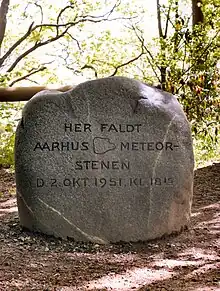| Aarhus | |
|---|---|
 Memorial stone for the 300 g part found in Riis Skov. The contours of this piece is depicted. | |
| Type | Chondrite |
| Class | Ordinary chondrite |
| Group | H6 |
| Country | Denmark |
| Region | Region Midtjylland |
| Coordinates | 56°11′N 10°14′E / 56.183°N 10.233°E[1] |
| Observed fall | Yes |
| Fall date | 2 October 1951 |
| Found date | 2 October 1951 |
| TKW | 720g (300g and 420g) |
Aarhus is an H chondrite meteorite that fell to earth on 2 October 1951 at 18:15 in Aarhus, Denmark. The meteor split just before the otherwise undramatic impact and two pieces were recovered. They are known as Aarhus I (at 300g) and Aarhus II (at 420g). Aarhus I was found in the small woodland of Riis Skov, just a few minutes after impact.[2][3]
Classification
It is an H chondrite and belongs to the petrologic type 6, so it was assigned to the H6 group.[1]
See also
References
- 1 2 Meteoritical Bulletin Database: Aarhus
- ↑ Grady, Monica M (31 August 2000). Catalogue of Meteorites. London: Natural History Museum, Cambridge University Press. p. 55. ISBN 978-0-521-66303-8. Retrieved 30 April 2014.
- ↑ StenoMusen 15. Pictures of the pieces.
Sources
- "Aarhus-meteoret" (PDF). StenoMusen 15 (in Danish). The Steno Museum. October 2001. pp. 4–5. Retrieved 30 April 2014.
This article is issued from Wikipedia. The text is licensed under Creative Commons - Attribution - Sharealike. Additional terms may apply for the media files.